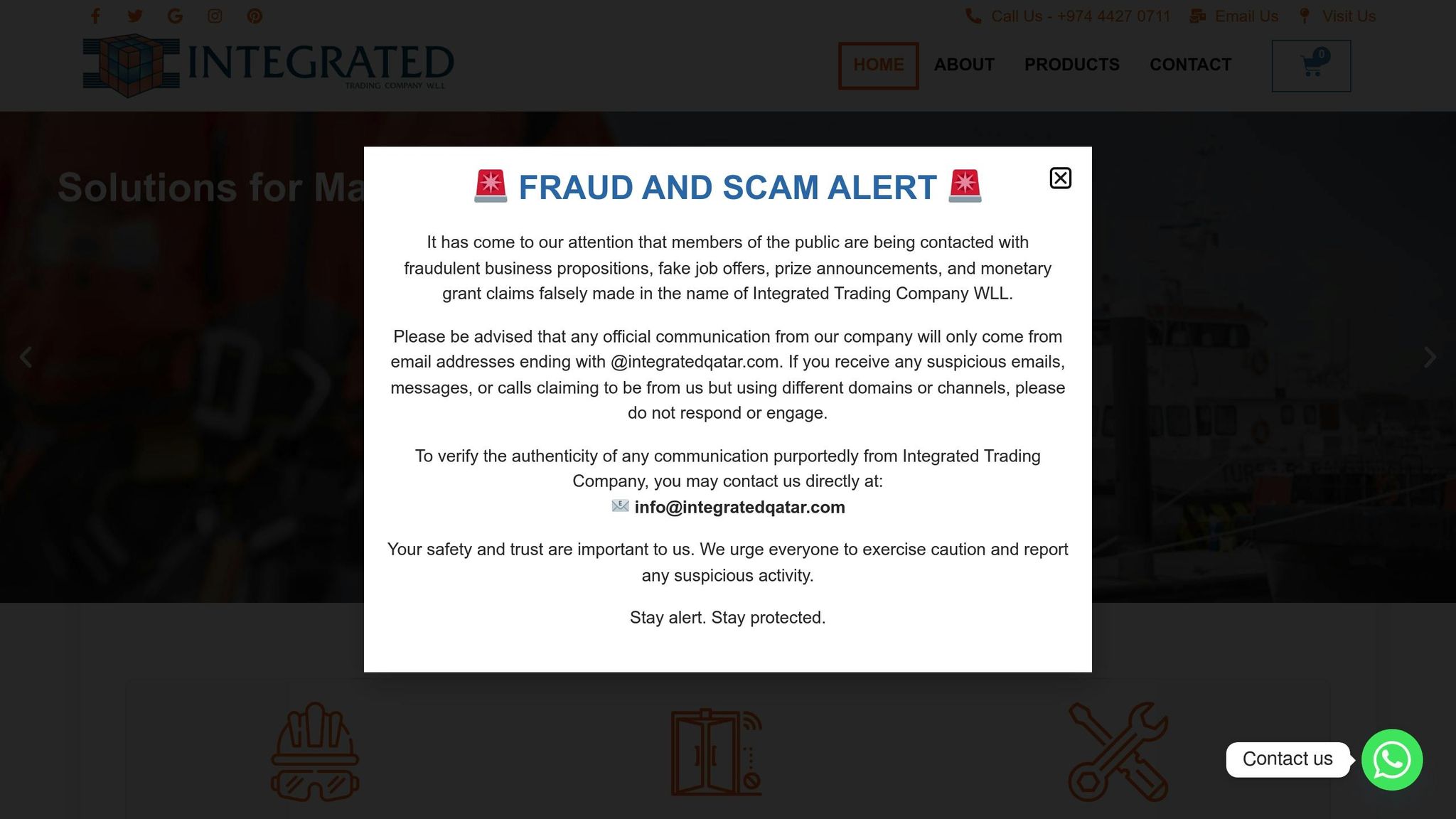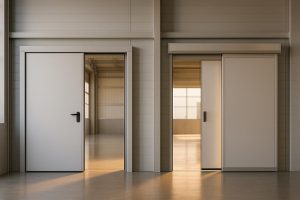
When deciding between manual and automatic doors for industrial use in Qatar, the choice depends on your priorities: cost, efficiency, safety, and maintenance. Here’s a quick breakdown:
Key Factors to Consider:
| Feature | Manual Doors | Automatic Doors |
|---|---|---|
| Initial Cost | Lower (Approx. QAR 1,125) | Higher (Approx. QAR 15,000+) |
| Maintenance | Minimal, simple upkeep | Frequent, specialised servicing |
| Efficiency | Slower, may cause delays | Faster, supports smooth workflows |
| Energy Use | Often inefficient | Energy-saving, controlled closing |
| Safety | Basic, risk of misuse | Advanced features, safer access |
| Best For | Low-traffic, budget settings | High-traffic, secure facilities |
Whether you prioritise cost or performance, the right choice depends on your facility’s needs. For high-traffic or safety-critical operations, automatic doors are worth the investment. For simpler setups, manual doors are a practical option.
Manual doors play a key role in Qatar’s industrial sector, offering dependable, non-powered operation. Below, we explore their features, advantages, and challenges within various industrial applications.
In Qatar, manual doors are integral to industries like warehousing, particularly in cold storage facilities. These doors, such as manual sliding models, help maintain stable temperatures, which is essential for preserving perishable goods. They are also a practical choice for areas with infrequent access needs or where high-speed operation isn’t a priority.
Manual doors are a popular choice among cost-conscious industrial operators in Qatar. They are affordable to install and require minimal maintenance, typically limited to routine inspections and lubrication. This simplicity keeps operational costs low. For example, manual sliding doors help reduce energy usage by limiting cold air loss during operation, making them effective for temperature control and lowering energy bills.
Another key advantage is their independence from power sources. This ensures they remain functional during power outages, a critical feature in industrial settings. Additionally, their design often takes up less space than swing doors, which can be beneficial in compact or crowded environments.
Despite their benefits, manual doors come with certain challenges. Accessibility can be an issue, particularly in facilities where workers use heavy equipment or have mobility restrictions. In high-traffic areas, the need for manual operation can slow down workflows, reducing overall efficiency.
Safety is another concern. While manual doors are operational during power outages, they can hinder quick evacuations if workers are unfamiliar with override procedures or if the door sustains damage. Regular maintenance is essential to ensure safe and efficient functionality. Studies also suggest that in high-pressure industrial settings, prioritising productivity can sometimes lead to improper use of manual doors, increasing wear and tear.
Lastly, manual doors generally lack modern features like integration with building management systems. Functions such as access logging or remote monitoring often require additional retrofit kits, which can add to costs and complexity. These limitations may affect both safety and efficiency in demanding environments.
Unlike manual doors, automatic systems simplify operations in busy industrial environments. They have become an essential feature in Qatar’s industrial sector, designed to meet the high demands of local industries. These systems go beyond basic entry and exit functions, offering advanced features tailored to specific needs.
Automatic doors rely on sensor technology for hands-free activation, often combined with push-button controls to ensure secure access, especially when handling materials. In Qatar’s industrial facilities, these doors are engineered to address unique operational challenges. For instance, high-speed rolling doors open at speeds of 1.0–1.5 m/s, significantly improving the flow of goods and materials. Additionally, these systems can integrate with building management platforms, enabling programmable schedules and remote monitoring.
Different types of automatic doors cater to various industrial uses across Qatar. High-speed rolling doors are ideal for warehouses and production areas, while insulated high-speed doors are particularly useful in cold storage facilities, where maintaining strict temperature control is crucial in Qatar’s hot climate.
| Door Type | Opening Speed | Material | Wind Resistance | Best Applications |
|---|---|---|---|---|
| High-speed rolling door | 1.0 to 1.5 m/s | PVC | 7 wind pressure | Warehouse, production workshop |
| High-speed zipper door | 1.5 to 2.0 m/s | PVC | 6 wind pressure | Food factory, clean room |
| Insulated high-speed door | 1.0 to 1.5 m/s | PVC/aluminium alloy | 7-level wind pressure | Cold storage, cold chain storage |
These advanced capabilities not only enhance efficiency but also contribute to safety and operational reliability in industrial settings.
The advantages of automatic doors extend well beyond convenience. One of the primary benefits is improved security. These systems can be programmed to allow entry only to authorised personnel, with features like verified identification and automatic locking outside business hours. This reduces the need for constant manual supervision.
“The primary benefit of utilising automatic doors is that they are contactless and safe and reduces hand contact with outside door handles.” – Stebilex Doha, Qatar
Energy efficiency is another key advantage. Studies show that door openings and access points account for up to 11% of energy loss in buildings. Insulated high-speed doors help minimise this loss, with U-values of less than 1.0 W/m²K, ensuring better temperature control and reducing cooling costs – an important factor in Qatar’s climate.
Operational efficiency also gets a boost. Automatic doors streamline the movement of goods and materials, reducing delays and improving workflow. Their contactless operation lowers the risk of injuries caused by accidental door closures and eases physical strain on workers.
Safety features include automatic detection systems to prevent accidents and manual overrides for power outages. Integration with access control systems allows customisation, ensuring only authorised personnel can enter specific areas at designated times. The growing focus on workplace safety and the adoption of IoT-enabled smart automation solutions are further accelerating the use of automatic doors in Qatar’s industrial sector.
Despite their many benefits, automatic doors come with challenges that industrial operators in Qatar must address. One of the biggest hurdles is the high initial cost. Installing these systems is significantly more expensive than manual alternatives. In 2023, the global automated industrial door market was valued at USD 2,495.48 million, reflecting the substantial investment required.
Their dependence on electricity is another drawback. While most systems include manual override options, power outages can disrupt critical operations. Ensuring that staff are trained in emergency procedures is essential to maintain safety and productivity during such situations.
Maintenance is another area of concern. Automatic doors require more frequent and specialised care compared to manual systems. Regular cleaning, inspections, and lubrication are necessary to keep them functioning properly. Repairs often involve complex electronic components, requiring skilled technicians, which can lead to delays and higher costs if expertise isn’t readily available.
The rapid pace of technological change adds another layer of complexity. Systems need regular updates to stay compatible with evolving market demands. Additionally, the shortage of skilled labour for installation and maintenance can hinder the long-term success of these systems.
Over time, the costs of maintenance, replacement parts, and system upgrades can add up, making automatic doors a more expensive option in the long run. Companies must factor these expenses into their budgets, especially when compared to the minimal upkeep required for manual doors.
Lastly, the competitive nature of the automatic door market can make it difficult to choose reliable suppliers. Selecting systems with strong after-sales support and warranties is crucial for ensuring consistent performance. Consulting with professional installers or manufacturers can help businesses navigate these challenges and select the right system for their specific needs.
When comparing door systems in Qatar, it’s clear that manual and automatic doors each have unique strengths and weaknesses when it comes to safety and operational efficiency. These differences directly influence workplace productivity and employee well-being.
The safety considerations for manual and automatic doors are nuanced. As Michael Panish, a Door & Automatic Door Expert Witness, puts it:
“If either manual or automatic doorways are not properly maintained, then both of these options become potentially dangerous”.
The risks, however, vary between the two systems. Manual doors can lead to musculoskeletal injuries and accidents, particularly when worn or faulty components compromise their safety . On the other hand, automatic doors eliminate physical strain but come with their own challenges, such as sensor malfunctions or power outages.
Modern automatic doors have addressed many of these issues with features like programmable emergency openings, battery backups, and manual overrides to ensure they function even during power failures. These systems are especially valuable in critical situations. For example:
“Automated doors play an integral role in ensuring rapid access for first responders while also providing rapid evacuation for staff.”
– Cheshire Industrial Doors
In industries like petrochemicals, which are prominent in Qatar, automatic doors offer an added layer of safety by quickly isolating hazardous areas during emergencies. However, proper maintenance is vital for both systems. With Qatar reporting 2.29 occupational fatalities per 100,000 workers in 2020, sticking to rigorous maintenance schedules is non-negotiable.
Beyond safety, the operational efficiency of these door systems becomes a key factor, particularly in fast-paced industrial environments.
Automatic doors, particularly high-speed rolling models, operate at speeds of 1.0–1.5 m/s, significantly reducing the time required for goods to move in and out of facilities. This efficiency not only speeds up logistics but also helps conserve energy – especially in temperature-controlled environments where limiting cold air loss is crucial .
Manual doors, by contrast, can slow down workflows. Workers often have to stop what they’re doing to open or close them, creating bottlenecks in high-traffic areas. Automatic doors also improve hygiene with their contactless operation, which is particularly beneficial in sensitive areas where contamination risks must be minimized .
While power outages or sensor failures can temporarily disrupt automatic systems, most include manual override options to ensure operations continue smoothly.
Here’s a closer look at how manual and automatic doors stack up against each other in terms of safety and efficiency:
| Feature | Manual Doors | Automatic Doors |
|---|---|---|
| Safety | Prone to musculoskeletal injuries and accidents due to component failures . | Reduces physical strain and provides quick emergency access, though requires regular sensor maintenance. |
| Efficiency | Slower throughput, often causing delays in busy areas. | Faster throughput, supporting uninterrupted workflows . |
| Accessibility | May not fully accommodate all accessibility needs. | Can be tailored for full accessibility. |
| Maintenance | Simpler and lower-cost maintenance but risky if neglected . | Requires specialised servicing but includes advanced safety features. |
| Energy Use | Often left open, leading to energy inefficiency. | Operates only when needed, conserving energy in controlled environments . |
When it comes to optimising industrial operations in Qatar, balancing costs with reliability is crucial. Deciding between manual and automatic doors requires careful thought about initial expenses, maintenance needs, and long-term benefits.
Understanding both upfront and ongoing costs is key to making an informed decision about door systems.
Manual doors are typically less expensive to purchase and install compared to automatic options. For instance, in the UK, basic manual doors start at around £150 (approximately QAR 1,125), with installation costs ranging from £100 to £300 (QAR 750–2,250).
On the other hand, automatic sliding doors demand a higher initial investment due to their advanced technology. Prices for basic models begin at approximately £2,000 (around QAR 15,000) and can go beyond £5,000 (roughly QAR 37,500) for premium models. Installation costs for these systems range between £500 and £1,500 (QAR 3,750–11,250).
Maintenance costs also differ significantly. Manual doors, with their simpler mechanics, require less frequent servicing, mainly involving lubrication and occasional adjustments. In contrast, automatic doors demand regular maintenance to ensure sensors, motors, and control systems remain in proper working order, which can result in higher ongoing expenses. As noted by ABC Industrial Doors:
“Automatic doors also require regular maintenance and checks to ensure the doors are functioning safely and properly. This can also be expensive. If repairs are needed, this is another costly procedure to consider.”
Additionally, maintaining automatic doors often involves cleaning, polishing, and oiling to prevent rust. Integration with access control systems further adds to the complexity and cost of upkeep.
While manual doors are budget-friendly upfront, automatic doors can deliver savings over time. Their ability to close quickly helps reduce heat loss or gain, which is particularly beneficial for facilities that require strict temperature control.
Manual doors, thanks to their straightforward design, can last a long time with proper maintenance. However, they may not always meet modern accessibility standards. Automatic doors, meanwhile, significantly improve accessibility – an important consideration, especially in environments where compliance with regulations for individuals with disabilities is required.
In high-traffic areas, automatic doors also experience less wear since they eliminate the need for manual operation, potentially extending their lifespan. The decision ultimately hinges on factors like budget, traffic flow, accessibility needs, and security requirements.
| Cost Factor | Manual Doors | Automatic Doors |
|---|---|---|
| Initial Purchase | ~QAR 1,125 | ~QAR 15,000+ |
| Installation | QAR 750–2,250 | QAR 3,750–11,250 |
| Maintenance | Low frequency – simple | High frequency – regular |
| Long-Term Value | Lower initial cost | Energy savings potential |
These cost considerations, alongside safety and efficiency aspects, provide a complete picture for evaluating door systems.

Beyond the numbers, reliable support plays a significant role in maximising the value of door systems.
With 18 years of experience in Qatar, Integrated Trading L.L.C offers door solutions designed to enhance operational efficiency. Their team ensures clients select the right system for their specific needs, avoiding costly mismatches. On-time delivery and high-quality products further reduce the risk of delays and early failures.
Integrated Trading L.L.C also provides access to genuine replacement parts and specialised maintenance services, which are particularly important for the upkeep of automatic doors. Their consultation services help businesses assess the total cost of ownership, considering factors like energy efficiency, maintenance demands, and compliance with local safety standards. This comprehensive approach ensures clients get the most out of their investment, whether they choose manual or automatic systems.
In Qatar’s industrial sector, manual and automatic doors cater to different operational needs, each bringing distinct benefits to the table.
Manual doors are often praised for their affordability and dependability. Their straightforward mechanical setup means fewer breakdowns and lower maintenance costs over time. On the downside, they require physical effort to operate and might not align with modern accessibility standards, especially in environments where compliance with disability regulations is essential.
Automatic doors, while requiring a larger upfront investment, offer a range of operational perks. These include better accessibility, energy savings through controlled opening and closing, and seamless integration with advanced security systems. Their touch-free operation is particularly valuable in industrial settings where hygiene and safety take precedence.
Regardless of the choice, both types of doors need regular maintenance to ensure they operate safely and efficiently. These differences are crucial when deciding which door system suits your facility best.
Selecting the ideal door system boils down to specific operational priorities. Based on the differences outlined above, consider these key factors: safety needs, traffic levels, accessibility requirements, and long-term costs.
For facilities with high traffic, automatic doors are often worth the higher initial expense. High-speed automatic doors, which can operate at speeds of 1.0 to 1.5 metres per second, enhance workflow efficiency and reduce energy waste. They are especially beneficial in temperature-controlled environments where maintaining consistent conditions is critical.
Smaller facilities or those operating on tighter budgets may find manual doors a more practical option. With proper maintenance and adherence to safety standards, manual doors work well in moderate-traffic areas where alternative accessibility solutions are already in place.
Climate conditions in Qatar also play a significant role in the decision-making process. Doors with strong weather resistance are a must. For facilities that rely on temperature-sensitive operations, insulated high-speed doors with U-values below 1.0 W/m²K can lead to considerable energy savings.
When security is a primary concern, automatic systems stand out. They can integrate seamlessly with advanced access control technologies like biometric scanners, coded keypads, and UHF readers. This makes them particularly suitable for industries handling sensitive materials or requiring strict access restrictions.
Ultimately, the right choice depends on your facility’s specific traffic flow, security needs, accessibility demands, and maintenance expectations. For high-frequency operations or safety-critical environments, automatic doors with sensor-based detection systems are often the best fit.
Partnering with experienced suppliers is key to ensuring you select a system that aligns with your operational goals. This not only helps avoid costly mismatches but also maximises the long-term value of your investment.
When choosing between manual and automatic doors for industrial use in Qatar, it’s important to weigh factors like safety, efficiency, and the specific demands of your facility.
Automatic doors are a great fit for areas with high foot traffic or environments where hygiene is critical. Their contactless operation minimizes contamination risks, making them ideal for sensitive spaces. Many models also come equipped with safety sensors and access control systems, offering secure and seamless access. These doors are perfect for industries that prioritize convenience and automation.
In contrast, manual doors stand out for their sturdiness, minimal maintenance needs, and reliability in locations where electricity supply might not be consistent. They are especially suitable for industries that require heavy-duty designs or prefer a more traditional appearance.
When deciding, also factor in cost, maintenance demands, and the available space for installation. Taking the time to evaluate these aspects will help you choose a solution that meets your operational needs and aligns with Qatar’s safety standards.
Automatic doors play a key role in improving energy efficiency in busy industrial spaces. Thanks to their quick open-and-close mechanisms, they help limit energy loss by keeping indoor temperatures stable. This is especially valuable in Qatar, where maintaining cool interiors is a constant challenge due to the region’s high temperatures. The result? Lower heating and cooling expenses, which is a win for both businesses and the environment.
When it comes to security, automatic doors offer more than just convenience. They allow controlled access, ensuring that only authorised individuals can enter restricted zones. Additionally, they help manage the flow of people and vehicles, cutting down on congestion and keeping operations running smoothly. For industrial facilities focused on balancing efficiency with safety, automatic doors are a smart, practical solution.
Manual doors are pretty low-maintenance. A bit of cleaning now and then, along with lubricating the hinges, is usually all they need. These simple tasks keep them working smoothly without adding much to your long-term expenses.
Automatic doors, however, require more attention. They need biannual check-ups to keep key parts like sensors, belts, gears, and guide rails in good shape. While this does mean higher upkeep costs over time, regular maintenance is crucial. It ensures the doors stay safe, reliable, and avoids expensive repairs – especially in busy industrial areas where they’re used constantly.
So, when deciding between manual and automatic doors, don’t just think about the initial price. Factor in the ongoing maintenance requirements to choose what works best for your industrial needs.

He Established Integrated Trading Company L.L.C in 2006 at qatar , and has partnered with high quality international manufacturers that represent the best in each of our product categories.
With over 2 decades of experience running the company , he shares his valuable insights that he learned from being in the market through this blog


